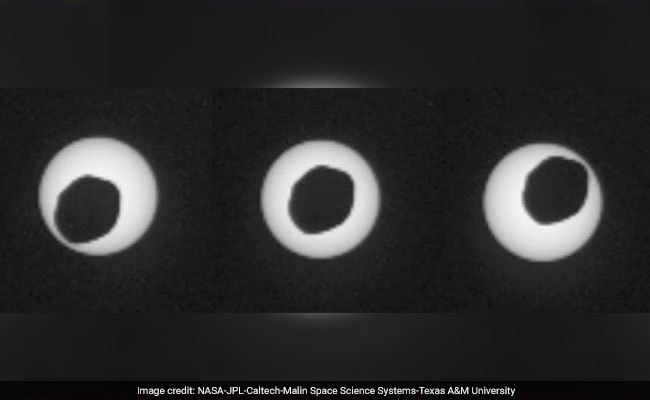If you think solar eclipses on Earth are cool, wait till you get a load of an eclipse on Mars. A person standing on Mars would see it cross the sky twice in one day. Because of its small size, it appears smaller than our own moon does to us.
Earth typically experiences four to seven eclipses a year, counting partial solar eclipses (when the moon doesn't fully obscure the sun) and lunar eclipses (when the earth's shadow partially obscures the moon).
On Mars, however, solar eclipses are practically a daily event. Mars has two moons - tiny, potato-shaped satellites named Phobos and Deimos, after the Greek deities of fear and dread, respectively.
But Mars's moons orbit at a much closer distance than our own Moon orbits ours. While the moon is about 238,000 miles away from Earth (give or take), Phobos is only about 6,000 miles away from the surface of Mars.
Among other things, that proximity causes it to rotate incredibly fast, circling around Mars in under eight hours. A person standing on Mars would see it cross the sky twice in one day. Because of its small size, it appears smaller than our own moon does to us.
Phobos's close, fast orbit makes it cross paths with the sun fairly often - near-daily. But because the moon is so small it never fully occludes the sun to create a total eclipse. Part of the sun's disc is always visible.
What about the other Martian moon? Deimos orbits more than twice as far away from Mars and is smaller to boot, making it much less visible in the Martian sky. When Deimos crosses paths with the sun, it's more properly called a transit, rather than an eclipse.
Other planets experience eclipses, too, although we haven't observed any of them from the ground up. Here, for instance, is a Hubble telescope image of Jupiter's moon Io casting a shadow on Jupiter's surface.
From Jupiter, the sun appears much smaller than it does in our own sky. A number of the planet's moons obscure it completely, creating not an eclipse but an occultation - an astronomical term for when one object is completely hidden by another one of much larger apparent size. Because Jupiter has at least 69 moons, it sometimes experiences multiple eclipses and occultations simultaneously.
A similar situation holds on Saturn, Uranus and even faraway Neptune. Eclipses can happen on Pluto, too.
But our own total eclipses on Earth are one-of-a-kind. Because of the similarity between the apparent sizes of the moon and sun when viewed from Earth, our total eclipses block out the entirety of the sun's disc while leaving the luminous corona - the sun's fiery atmosphere - plainly visible in the darkened sky.
That event happens nowhere else in the solar system - not even on Mars.

No comments:
Post a Comment